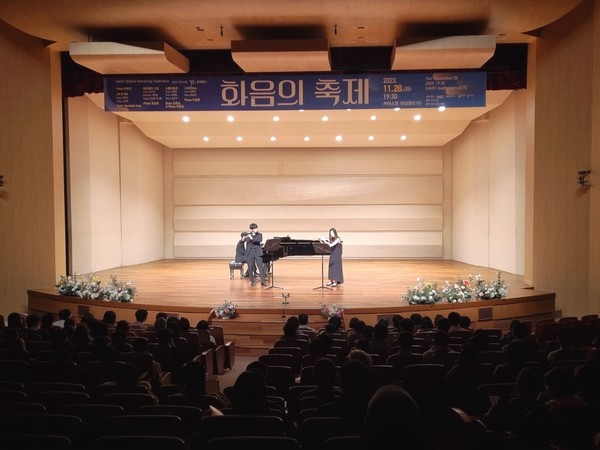Spending an evening captivated by the rich instrumental tones and emotions at a music recital. Leisurely admiring colorful paintings while strolling through a museum. Enjoying the deft movements of dancers at a dance show. Oftentimes, these experiences seem like a luxury, especially during the busiest weeks of the academic semester. While free tickets to classical concerts are regularly released through the Portal, deciding to go means committing a significant amount of time to travel to and from the Daejeon Arts Center, at least 15 minutes in advance to collect tickets, and watch the show. The same goes for other performances or museums, not to mention that Daejeon is not the most popular of towns for concerts despite it being one of the six Korean “metropolitan cities”.
The KAIST Cultural Festivals provide opportunities that overcome these limitations to a significant extent. The KAIST Cultural Festivals have invited professional artists in various performing arts fields to a series of six to eight performances per semester. Arguably, the primary benefit is the venue: the Auditorium (E15). As the performances are held on campus, the transportation time required drastically decreases. Thus, students are more likely to make a visit when coming across an event notice that mildly piques their interest. Another major advantage of the cultural events at KAIST is that they are free of charge. Seong Eun Son, the director of the KAIST Cultural Festivals, noted that it is difficult to find universities that host such school-funded programs regularly. These factors contribute to increasing the accessibility of musical events for KAIST students, as it reduces the burden psychologically and financially.
Serving as a break from the demands of academics is the major and undeniably important aim of the KAIST Cultural Festivals. Taking in visual and aural entertainment away from our daily lives can relieve stress and refresh the mind, perhaps even have cognitive benefits, as studies suggest. And despite being free performances, their quality is not compensated — numerous world-renowned artists have visited the Auditorium, such as violinists Clara-Jumi Kang and Guido Sant’Anna, pianist Yunchan Lim, and soprano Sumi Jo, among many other winners of musical competitions — adding to the enjoyment. The engagement with the performer and the music makes the emotions more memorable and the experience more immersive; it is a privilege that such performances are more readily accessible.
The scope of the Cultural Festivals has also expanded in genre and form. While classical music has inevitably been most frequent, other genres such as jazz, traditional Korean music, and a cappella have consistently been showcased. Dance performances including the recent Dance with KAIST Vol.1 have been organized, looking to better encompass diverse interests within the KAIST community. More amusing projects such as Four Seasons 2050, which modified Vivaldi’s “Four Seasons” with artificial intelligence based on the climate change scenario, demonstrated integration of science and the arts. Combined with the accessibility of KAIST Cultural Festivals, students are encouraged to watch events of relatively unfamiliar genres, enhancing individual cultural enrichment. In addition, the ventures into creating new formats of performances such as the Lunch Concerts explore ways to engage more people on campus.

On November 28, these scopes were expanded even further. The Harmony of KAIST event called willing members of KAIST to showcase their musical talent and passion through a participatory concert. Minju Hong, who coordinated the event, explained that the event intended to give an opportunity for talented musicians at KAIST to take the stage. Moreover, by arranging piano, string, wind, and vocal music within a single performance, the beauty and diversity of music within our campus could be highlighted and appreciated.
Harmony of KAIST changed the perception of KAIST Cultural Festivals from simply a place to appreciate the performing arts to a place for artistic interaction. The nature of the event, with each team preparing 8 to 10 minutes of music, acted as a means for this interaction. One of the participants shared that the length was manageable to “ease the burden of extensive practice sessions, but also satiated the desire to perform on stage.” The bringing together of KAIST members ranging from students to faculty to perform various pieces of unique character made the concert meaningful, both for the performers and the audience. In particular, with performers encouraging each other backstage and in the audience seating, many noted that it was “valuable to meet people who share similar hobbies and passions.” The KAIST Cultural Event thus opened new chances for self-expression and strengthened connections within the community.
With the recent establishment of the Arts Convergence Center and the soon-to-be-opened KAIST Museum, it seems that cultural opportunities on campus will continue to increase. The organizers of Cultural Festivals have also revealed aspirations to continue to introduce new formats and improve diversity in repertoire. Exposing yourself to opportunities leads to new interests and hobbies, along with a broadened way of thinking. The KAIST Cultural Festivals have personally been one such opportunity, and it is expected to present itself in the same way for other KAIST members.

